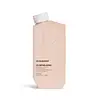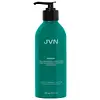What's inside
What's inside
 Key Ingredients
Key Ingredients

 Benefits
Benefits

 Concerns
Concerns

 Ingredients Side-by-side
Ingredients Side-by-side

Water
Skin ConditioningSodium Methyl 2-Sulfolaurate
CleansingSodium Cocoyl Isethionate
CleansingCocamidopropyl Hydroxysultaine
CleansingDisodium 2-Sulfolaurate
CleansingPEG-2 Cocamide
EmulsifyingCocamidopropyl Betaine
CleansingPEG-150 Distearate
EmulsifyingPanthenol
Skin ConditioningZingiber Officinale Root Extract
MaskingUrtica Dioica Extract
AstringentOleanolic Acid
Skin ConditioningAesculus Hippocastanum Seed Extract
Skin ConditioningEuterpe Oleracea Fruit Extract
Bambusa Vulgaris Leaf/Stem Extract
HumectantOryza Sativa Bran Oil
EmollientSilk Amino Acids
HumectantRice Amino Acids
Skin ConditioningKeratin Amino Acids
Skin ConditioningAloe Barbadensis Leaf Juice
Skin ConditioningCreatine
Skin ConditioningApigenin
AntioxidantBiotinoyl Tripeptide-1
Lactic Acid
BufferingZinc Picolinate
SoothingGlycerin
HumectantIsopropyl Alcohol
SolventButylene Glycol
HumectantPropanediol
SolventButyloctanol
HumectantDicetyldimonium Chloride
EmulsifyingSilicone Quaternium-16
Skin ConditioningPPG-26-Buteth-26
Skin ConditioningGlycol Distearate
EmollientGuar Hydroxypropyltrimonium Chloride
Skin ConditioningUndeceth-11
EmollientPEG-120 Methyl Glucose Trioleate
CleansingSteareth-4
EmulsifyingPEG-40 Hydrogenated Castor Oil
EmulsifyingUndeceth-5
EmulsifyingPolyquaternium-7
Polyquaternium-10
Disodium EDTA
Trisodium Hedta
Phenoxyethanol
PreservativeEthylhexylglycerin
Skin ConditioningChlorphenesin
AntimicrobialSorbic Acid
PreservativeBenzoic Acid
MaskingPotassium Sorbate
PreservativeSodium Benzoate
MaskingLactobacillus Ferment
Skin ConditioningLeuconostoc/Radish Root Ferment Filtrate
AntimicrobialIodopropynyl Butylcarbamate
PreservativeCitric Acid
BufferingParfum
MaskingBenzyl Benzoate
AntimicrobialBenzyl Salicylate
PerfumingHydroxycitronellal
PerfumingWater, Sodium Methyl 2-Sulfolaurate, Sodium Cocoyl Isethionate, Cocamidopropyl Hydroxysultaine, Disodium 2-Sulfolaurate, PEG-2 Cocamide, Cocamidopropyl Betaine, PEG-150 Distearate, Panthenol, Zingiber Officinale Root Extract, Urtica Dioica Extract, Oleanolic Acid, Aesculus Hippocastanum Seed Extract, Euterpe Oleracea Fruit Extract, Bambusa Vulgaris Leaf/Stem Extract, Oryza Sativa Bran Oil, Silk Amino Acids, Rice Amino Acids, Keratin Amino Acids, Aloe Barbadensis Leaf Juice, Creatine, Apigenin, Biotinoyl Tripeptide-1, Lactic Acid, Zinc Picolinate, Glycerin, Isopropyl Alcohol, Butylene Glycol, Propanediol, Butyloctanol, Dicetyldimonium Chloride, Silicone Quaternium-16, PPG-26-Buteth-26, Glycol Distearate, Guar Hydroxypropyltrimonium Chloride, Undeceth-11, PEG-120 Methyl Glucose Trioleate, Steareth-4, PEG-40 Hydrogenated Castor Oil, Undeceth-5, Polyquaternium-7, Polyquaternium-10, Disodium EDTA, Trisodium Hedta, Phenoxyethanol, Ethylhexylglycerin, Chlorphenesin, Sorbic Acid, Benzoic Acid, Potassium Sorbate, Sodium Benzoate, Lactobacillus Ferment, Leuconostoc/Radish Root Ferment Filtrate, Iodopropynyl Butylcarbamate, Citric Acid, Parfum, Benzyl Benzoate, Benzyl Salicylate, Hydroxycitronellal
Water
Skin ConditioningCetearyl Alcohol
EmollientHydrogenated Farnesene
EmollientBrassicamidopropyl Dimethylamine
Skin ConditioningCapryloyl Glycerin/Sebacic Acid Copolymer
Skin ConditioningSqualane
EmollientPhyllostachys Bambusoides Extract
Skin ConditioningGlycerin
HumectantBiotin
AntiseborrhoeicPanthenol
Skin ConditioningDiheptyl Succinate
EmollientCetearyl Olivate
Tocopherol
AntioxidantSorbitan Olivate
EmulsifyingAspartic Acid
MaskingSodium Gluconate
Skin ConditioningEthylhexylglycerin
Skin ConditioningBenzyl Alcohol
PerfumingParfum
MaskingLinalool
PerfumingWater, Cetearyl Alcohol, Hydrogenated Farnesene, Brassicamidopropyl Dimethylamine, Capryloyl Glycerin/Sebacic Acid Copolymer, Squalane, Phyllostachys Bambusoides Extract, Glycerin, Biotin, Panthenol, Diheptyl Succinate, Cetearyl Olivate, Tocopherol, Sorbitan Olivate, Aspartic Acid, Sodium Gluconate, Ethylhexylglycerin, Benzyl Alcohol, Parfum, Linalool
Ingredients Explained
These ingredients are found in both products.
Ingredients higher up in an ingredient list are typically present in a larger amount.
Ethylhexylglycerin (we can't pronounce this either) is commonly used as a preservative and skin softener. It is derived from glyceryl.
You might see Ethylhexylglycerin often paired with other preservatives such as phenoxyethanol. Ethylhexylglycerin has been found to increase the effectiveness of these other preservatives.
Glycerin is already naturally found in your skin. It helps moisturize and protect your skin.
A study from 2016 found glycerin to be more effective as a humectant than AHAs and hyaluronic acid.
As a humectant, it helps the skin stay hydrated by pulling moisture to your skin. The low molecular weight of glycerin allows it to pull moisture into the deeper layers of your skin.
Hydrated skin improves your skin barrier; Your skin barrier helps protect against irritants and bacteria.
Glycerin has also been found to have antimicrobial and antiviral properties. Due to these properties, glycerin is often used in wound and burn treatments.
In cosmetics, glycerin is usually derived from plants such as soybean or palm. However, it can also be sourced from animals, such as tallow or animal fat.
This ingredient is organic, colorless, odorless, and non-toxic.
Glycerin is the name for this ingredient in American English. British English uses Glycerol/Glycerine.
Learn more about GlycerinPanthenol is a common ingredient that helps hydrate and soothe the skin. It is found naturally in our skin and hair.
There are two forms of panthenol: D and L.
D-panthenol is also known as dexpanthenol. Most cosmetics use dexpanthenol or a mixture of D and L-panthenol.
Panthenol is famous due to its ability to go deeper into the skin's layers. Using this ingredient has numerous pros (and no cons):
Like hyaluronic acid, panthenol is a humectant. Humectants are able to bind and hold large amounts of water to keep skin hydrated.
This ingredient works well for wound healing. It works by increasing tissue in the wound and helps close open wounds.
Once oxidized, panthenol converts to pantothenic acid. Panthothenic acid is found in all living cells.
This ingredient is also referred to as pro-vitamin B5.
Learn more about PanthenolParfum is a catch-all term for an ingredient or more that is used to give a scent to products.
Also called "fragrance", this ingredient can be a blend of hundreds of chemicals or plant oils. This means every product with "fragrance" or "parfum" in the ingredients list is a different mixture.
For instance, Habanolide is a proprietary trade name for a specific aroma chemical. When used as a fragrance ingredient in cosmetics, most aroma chemicals fall under the broad labeling category of “FRAGRANCE” or “PARFUM” according to EU and US regulations.
The term 'parfum' or 'fragrance' is not regulated in many countries. In many cases, it is up to the brand to define this term.
For instance, many brands choose to label themselves as "fragrance-free" because they are not using synthetic fragrances. However, their products may still contain ingredients such as essential oils that are considered a fragrance by INCI standards.
One example is Calendula flower extract. Calendula is an essential oil that still imparts a scent or 'fragrance'.
Depending on the blend, the ingredients in the mixture can cause allergies and sensitivities on the skin. Some ingredients that are known EU allergens include linalool and citronellol.
Parfum can also be used to mask or cover an unpleasant scent.
The bottom line is: not all fragrances/parfum/ingredients are created equally. If you are worried about fragrances, we recommend taking a closer look at an ingredient. And of course, we always recommend speaking with a professional.
Learn more about ParfumWater. It's the most common cosmetic ingredient of all. You'll usually see it at the top of ingredient lists, meaning that it makes up the largest part of the product.
So why is it so popular? Water most often acts as a solvent - this means that it helps dissolve other ingredients into the formulation.
You'll also recognize water as that liquid we all need to stay alive. If you see this, drink a glass of water. Stay hydrated!
Learn more about Water